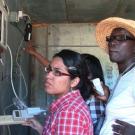Report from the UC Davis D-Lab with information on stakeholder analysis, simulation scenarios, results and recommendations.
The CoolBot coolroom system is a single-purpose post-harvest cold storage technology that transforms a wall-mounted air conditioning unit into a small-scale refrigeration system. This ability to store crops in low temperatures can extend the shelf-life of perishable horticultural crops and mitigate the lost revenue resulting from post-harvest losses faced by farmers in developing countries such as Uganda, in which there presently is no cold supply chain and therefore suffers from post-harvest loses of up to 30% of horticultural harvest. By reducing the loss in marketable products, livelihoods of limited-resource farmers could be advanced. With this in mind, the immediate objective of this research project is to evaluate and assess the necessary pre-conditions and circumstances contributing to the economic feasibility of adopting the CoolBot Coolroom system. The project site is within the Arua District of Uganda, and the assessment utilizes geographically, economically, sociologically, and agro-ecologically data specific to this region to simulate thermal behavior of the coolroom in order to establish and evaluate the payback period of the system for five possible consumers in three scenarios, if powered by: photo voltaic panels, a gasoline generator, and an electricity grid. From this sensitivity analysis, the relative benefit of the CoolBot Coolroom system is examined for those consumer profiles, and the economic feasibility for each investigated.

